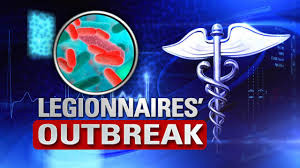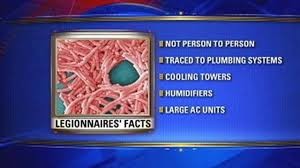Legionnaires’ disease is a severe form of pneumonia — lung inflammation usually caused by infection. Legionnaires’ disease is caused by a bacterium known as legionella.
Legionella bacteria are found naturally in freshwater environments, like lakes and streams. The bacteria can become a health concern when they grow and spread in human-made building water systems like
- Showerheads and sink faucets
- Cooling towers (structures that contain water and a fan as part of centralized air cooling systems for buildings or industrial processes)
- Hot tubs
- Decorative fountains and water features
- Hot water tanks and heaters
- Large, complex plumbing systems
Home and car air-conditioning units do not use water to cool the air, so they are not a risk for Legionella growth.
However, Legionella can grow in the windshield wiper fluid tank of a vehicle (such as a car, truck, van, school bus, or taxi), particularly if the tank is filled with water and not genuine windshield cleaner fluid.
You can’t catch Legionnaires’ disease from person-to-person contact. Instead, most people get Legionnaires’ disease from inhaling the bacteria. Older adults, smokers and people with weakened immune systems are particularly susceptible to Legionnaires’ disease.
The legionella bacterium also causes Pontiac fever, a milder illness resembling the flu. Separately or together, the two illnesses are sometimes called legionellosis. Pontiac fever usually clears on its own, but untreated Legionnaires’ disease can be fatal. Although prompt treatment with antibiotics usually cures Legionnaires’ disease, some people continue to experience problems after treatment.
Know this about Legionnaire’s disease, although the disease primarily affects the lungs, it occasionally can cause infections in wounds and in other parts of the body, including the heart.
Legionnaires’ disease usually develops two to 10 days after exposure to legionella bacteria. It frequently begins with the following signs and symptoms:
- Headache
- Muscle pain
- Chills
- Fever that may be 104 F (40 C) or higher
- By the second or third day, you’ll develop other signs and symptoms that may include:
- Cough, which may bring up mucus and sometimes blood
- Shortness of breath
- Chest pain
- Gastrointestinal symptoms, such as nausea, vomiting and diarrhea
- Confusion or other mental changesA mild form of Legionnaires’ disease — known as Pontiac fever — may produce signs and symptoms including fever, chills, headache and muscle aches. Pontiac fever doesn’t infect your lungs, and symptoms usually clear within two to five days.WHEN TO SEE A DOCTOR:
Who are at risk for Legionnaires’ disease:
Most healthy people exposed to Legionella do not get sick. People at increased risk of getting sick are:
- People 50 years or older
- Current or former smokers
- People with a chronic lung disease (like chronic obstructive pulmonary disease or emphysema)
- People with weak immune systems or who take drugs that weaken the immune system (like after a transplant operation or chemotherapy)
- People with cancer
- People with underlying illnesses such as diabetes, kidney failure, or liver failure
See your doctor if you think you’ve been exposed to legionella bacteria. Diagnosing and treating Legionnaires’ disease as soon as possible can help shorten the recovery period and prevent serious complications. For people at high risk, prompt treatment is critical.
updated 11/21/2023 by strive for good health.

